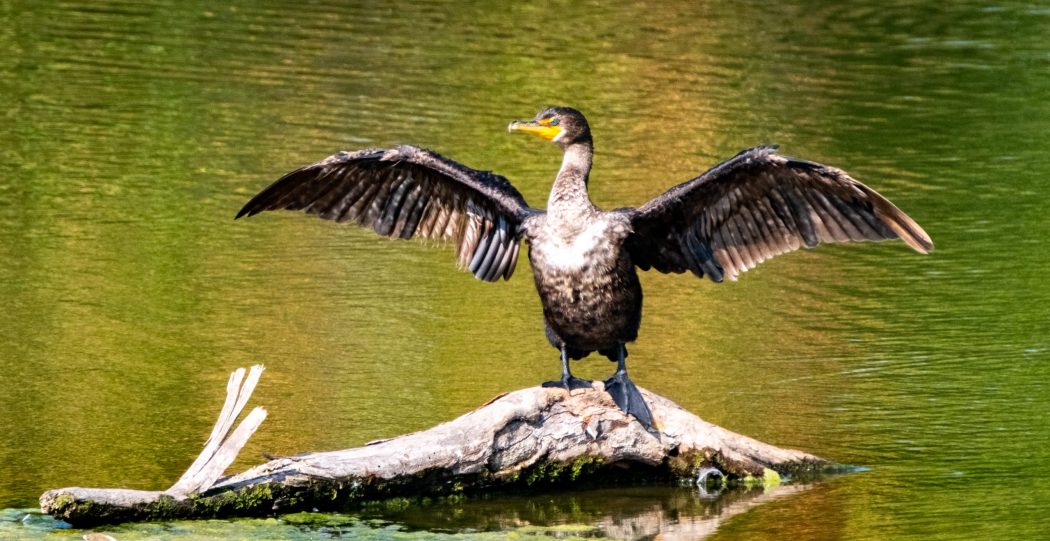Bird is the word

A double-crested cormorant suns itself on a log near the spillway at White Rock Lake, allowing its feathers to dry. (Photography by Marilyn Bishkin)
Maybe Bob Marley’s three little birds were right: “Every little thing’s gonna be all right.” It’s a message the world needs to hear. We need wisdom and comfort from nature. Fortunately, we can find it here in our neighborhood. At last count, White Rock Lake is home to 288 bird species.
When was the last time you really noticed and appreciated the birds at the lake? Natha Taylor, well known in the Dallas birding community, is here to help.
Birds are attracted to water, so it’s not too difficult to spot numerous species at the lake year-round. This season is particularly good for birdwatching because it’s migration time. North Texas is in the Central Flyway, a path between Canada and South America. Think of it as Interstate 35 for birds.
Although she’s not an ornithologist, Taylor has “always been one for the outdoors.” Her birding journey began in the 1990s, when she was returning from a trip to California and made a stop at Bosque del Apache National Wildlife Refuge in New Mexico.
“I saw my first rufous hummingbird, and I was hooked,” she says.
Since then, she has taken numerous courses from Cornell Lab of Ornithology and completed training to become a certified Master Naturalist. An active member of the North Texas Chapter of Master Naturalists, she has taught birding classes and led field trips at the lake for naturalists-in-training and for the public through the Dallas Public Library.
Taylor says all you need to get started is a pair of binoculars and a field guide for identifying birds. Once you arrive at your location, remember the basics: Stop. Be still. Clear your mind. Tune in to your surroundings. Think like a bird. Look at treetops, perches and power lines. Listen.
Taylor recommends three locations at the lake for prime viewing. The first area includes the spillway, the trail leading down the hill to the parking lot and the overlook. In the water, you’re likely to see a ring-billed gull or Franklin’s gull. Nearby you’ll find great blue herons and great egrets fishing. American coots, duck-like water birds with white bills, also like this spot.
Next, head down the trail to the treed area. Listen carefully, and you’ll hear the great crested flycatcher. Maybe you’ll spot it in the treetops. A tapping noise will give away the location of red-bellied and down woodpeckers. Their neighbors are probably the Carolina wren or chickadee and Northern mockingbird. Warblers, such as the black and white warbler, hang out here, too.
Don’t forget to look for barn swallows, chimney swifts and purple martins, as well as turkey and black vultures, the “cleanup crew” of nature, Taylor says. These birds scavenge for dead animals.
The second area for prime viewing is around the pump house and over to the bridge crossing the lake and inlet area.

An American white pelican stretches its wings.
“You’ll find a plethora of birds,” Taylor says.
Listen for killdeer or the tapping of a Northern flicker, a member of the woodpecker family. Perk your ears for the Eastern phoebe, a flycatcher that says its name. This is also a good spot for song sparrows and brown creepers, birds who glean the bark of trees for insects.
Look at perches, and you’ll likely see an American kestrel, a falcon that loves to eat grasshoppers, mice and sometimes other small birds. Of course, you’ll see plenty of monk parakeets, an invasive species that appeared around 1973 and were brought here as part of the pet trade. They have a large nesting area on the west side of the lake across from the pump house.
“Take note of their enormous nest,” Taylor says. “They are always renovating.”
As you pass the parking lot, walk closer to the lake, and you’ll likely see red-winged blackbirds in the reedy area, as well as pied-billed grebe, which dive dramatically into the lake for fish.
From the bridge, look for mallards, wood ducks and their ducklings. At Sunset Bay, on the east side of the lake, near Winfrey Point, you’ll see Canada geese and ducks, as well as pelicans, herons, egrets and the belted kingfisher. Year-round residents of the trees are the blue jay, American robin, Northern cardinal and Eastern bluebird. You’ll probably spot the mourning dove and white-winged dove on the ground, foraging for grain and insects.
“Birds and birding connect me with nature,” Taylor says.
Cornell Lab describes birds as “beacons of hope.” It could be that Bob Marley’s three little birds were wise beyond their years.
For more information, visit allaboutbirds.org and birds.cornell.edu.





